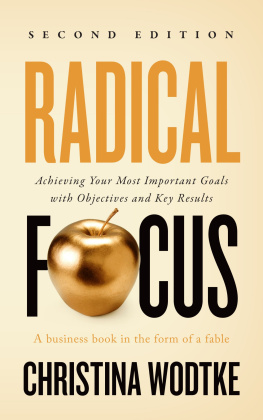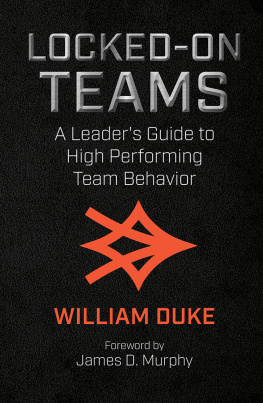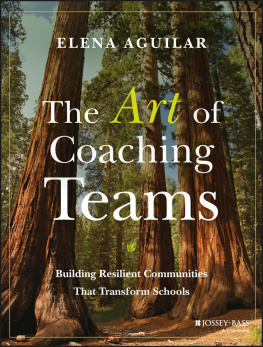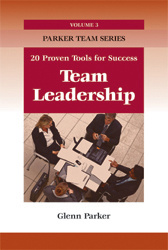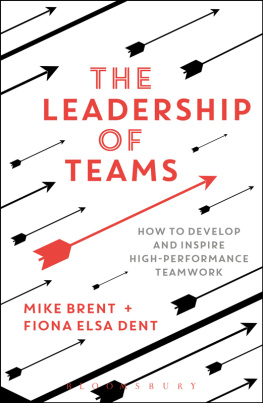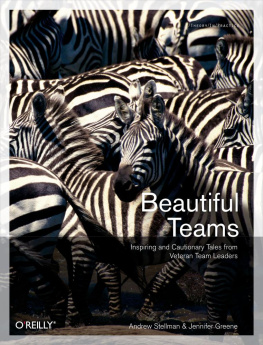I started my career 25 years ago and have been both a member and a leader of dozens of teams all over the world which means I feel fairly confident when I say that Ive seen almost every management style and team dynamic under the sun, from the functional to the deeply dysfunctional. Because despite how much lip service we pay to the importance of teams and teamwork (especially in todays increasingly complex environments), we spend far too little time actually focused on our teams and how they work together.
After much experimenting with all the wrong ways to lead teams, around 10 years ago my CTO and I realized that the closer we put decision making to the customer, the better the decisions became - so we started exploring how to give our teams more and more autonomy. It sounds so easy - hire people who are smarter than you are and get out of the way. Empowering our teams this way makes an innate sense and Ive yet to meet anyone who disagrees with the sentiment, but actually doing it well is surprisingly difficult.
As always the devil is in the details, and in the intervening years Ive learned that just hiring smart people isnt enough - we have to make sure they work (and play) well together too. So Ive spent the best part of the last 10 years figuring out how to make this happen, by trying (and sometimes failing) to implement autonomous teams in various companies as well as through evangelizing and learning about it through the product community I founded as well as hundreds of interviews with product leaders for my own book on the topic.
When Christina shared her first draft of this book so many of those different threads suddenly clicked together, and in her storytelling, she walked the hero of the story through the same journey Id been on for so long, in just a few short chapters. In short, this is the book I wish Id had 10 years ago, and I know it will make your journey to building high performing, autonomous, learning teams so much easier.
The Book That Didnt Want to Be Written
An Introduction to The Team That Managed Itself
This book. Oy, this book.
Radical Focus was a tough book to write, but in the way most books are hard to write. This book, The Team That Managed Itself, has been borderline cursed.
I started it in the NaNoWriMo of 2016. If you arent familiar with NaNoWriMo, its National Novel Writing Month, a goofy but wildly popular event in which you write a 50,000-word novel in one month. I took a class with the founder, Chris Baty, and every week Id sit in a room with twenty other intrepid writers desperately trying to hit my 1,667 words a day.
Chris wrote the book, No Plot? No Problem. Following that approach caused my first problem. Write whatever comes to mind! hed say, and I would. When I was done, I would have 50K words of... stuff. I wanted to write a story about a young woman who was promoted before she was ready, and suddenly had to figure out how to hire, fire, and give effective feedback so she could have the team she needed to succeed. What I had was a disastrous manuscript based on some of my worst work experiences that was 20 percent potential and 80 percent therapy.
I recall walking around a SoHo alleyway after giving a workshop, talking to my editor, Cathy Yardley, and crying, Can this book be saved? She said it could.
And then she got breast cancer. I was devastated. First, I had come to love her. She gives difficult feedback in a way that makes you feel you can fix anything, in a way that makes you believe you can be an author. And when she praises whats working, the insight and truth of it makes you feel like a superhero. She sees the writer you can be, and helps you become it.
I couldnt do this book without her. She went off to heal, and so did I (in a much much, much smaller way). I put the book I had code named Continuous Feedback away. I started drawing. A lot. I made a cute little workbook based on what I was learning about drawing.
My editor beat her cancer, and I am so grateful, mostly because the world needs her, but selfishly, because I need her. But our American health-care system made it necessary she take a full-time job to pay for her care. She left the thing she loved writing and editing to pay the bills. So I left Continuous Feedback in the drawer, so to speak. (Literally, in the Dropbox folder. But whaddya gonna do?) I couldnt face trying to make sense of the damn thing without Cathy.
Thus Pencil Me In was born. I wrote a book that didnt need her kind of editing. I wrote a book about drawing: How to draw and when to draw.
Pencil Me In was a work of pure joy. Every day I spent on it made me happy. It was a love poem to making marks that make you smart. It was the book that I hoped would sell, but didnt really need to, because writing it made me so much smarter. The book had done its job for at least one person.
Continuous Feedback was the opposite. Nothing about it was fun.
It was looking back at one of the hardest times of my life, combined with two other hardest times of my life. But then a miracle occurred: Cathy came back. She had found a way to afford to do the work she loved. And if she was willing to attack this beast, so could I. We ripped into it, bouncing outlines back and forth until we had a book that had hope in the darkness.
Continuous Feedback is a book about trying to make a good team in a toxic workplace, so I wrote a toxic workplace and immediately wanted out of there. In my head, I was screaming at my protagonist Allie to quit already! But I also knew why she wouldnt.
I wanted to have protagonists of color. But putting them in a toxic workplace meant dealing with microaggressions and mysterious career blockers. If you are a woman or a person of color in the Valley, you always wonder if you arent getting promoted because you arent good enough, or if its something else. There is an unsettling randomness in who gets ahead. Sometimes its you, but mostly its not. I dont know anyone who doesnt wonder, is it me or is it sexism/racism? The magazines celebrate those who make it despite prejudice, and you wonder why you arent that person. You wonder, What if I was just a bit smarter/tougher/nicer?
I also chose to make her a rarity in the Silicon Valley: a female general manager. I gave her an all-male engineering team, and the only women she worked with regularly were in design and human resources. I did this to increase the pressure on her. Any woman who has sat, as I have sat, in a room full of men knows how exhausting it can be. You feel like a freak. You wonder if you chose the right profession. You wonder if you might better have gone into marketing or HR. And then you take a big breath and move on.
As well, I wanted to do a lot of things I dont see in fiction enough. I wanted to write about friendships between men and women that didnt have to become romantic. I wanted a husband and wife who loved each other and were willing to put the work in to make the marriage function. Unspoken assumptions kill marriages as well as team health. The tensions between Allie and Dereks conflicting needs were a reflection of Allies workplace where so much was assumed and so much of that was wrong.


